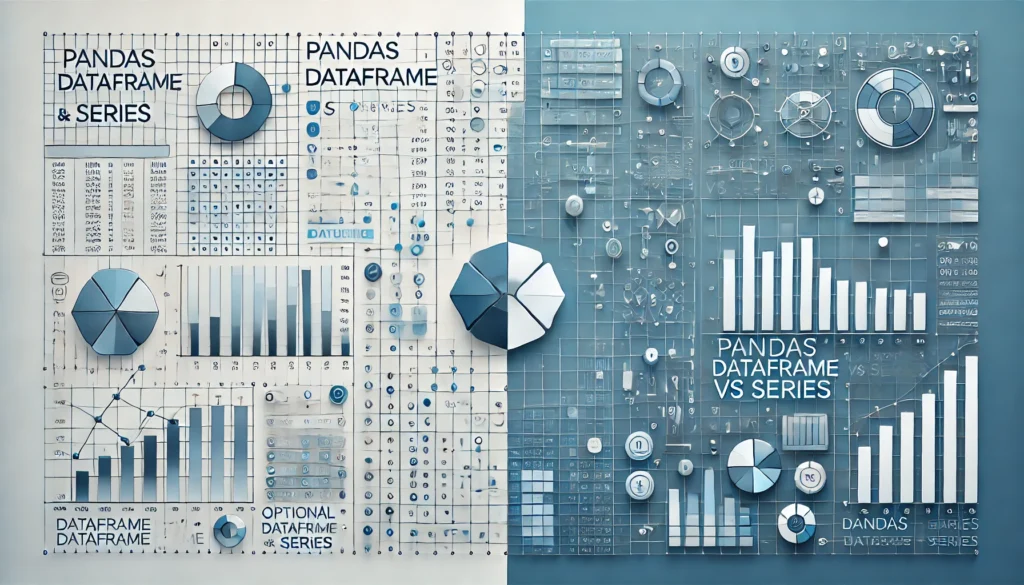Data manipulation and analysis in Python are often powered by Pandas, a popular library that makes it easy to handle complex data. Two essential structures in Pandas, the DataFrame and the Series, play a critical role in how data is organized, processed, and analyzed.
Understanding these two data structures will help you work more effectively with datasets, whether they are large tables or simple lists.In this guide, we’ll walk through what distinguishes DataFrames from Series in Pandas, why each is useful, and how to use them in your data work.
Table of Contents
ToggleWhat is a Pandas Series?
A Series is the simpler of the two structures. It is a one-dimensional array-like object, holding a sequence of values that could be of any data type, such as integers, strings, floats, or even other Python objects. Think of a Series as a single column in a spreadsheet or a single row of values.
Alongside each value, there’s an index, which serves as the identifier for each entry, making it easy to retrieve specific items.
Example:
import pandas as pd
# Creating a Pandas Series
data = pd.Series([10, 20, 30, 40])
print(data)
In this example, we’ve created a Series containing four numbers. Each number has an index (0, 1, 2, 3), which acts like a label, allowing us to quickly access and manipulate values in the Series.
Key Characteristics of a Series:
One-dimensional, like a list or array.Has a labeled index, which can be customized. Useful for storing data when you don’t need multiple columns.
What is a Pandas DataFrame?
A DataFrame is a more complex, two-dimensional structure and is arguably the most popular structure in Pandas. It’s similar to an Excel spreadsheet or a SQL table, where data is organized into rows and columns. Each column in a DataFrame is actually a Pandas Series, meaning you can think of a DataFrame as a collection of Series with the same index.
# Creating a Pandas DataFrame
data = { 'Name': ['Alice', 'Bob', 'Charlie'], 'Age': [24, 27, 22], 'City': ['New York', 'Los Angeles', 'Chicago']}df = pd.DataFrame(data)
print(df)Here, we created a DataFrame with three columns: “Name,” “Age,” and “City.” Each column is essentially a Series with a shared index, which organizes the data into rows.
Key Characteristics of a DataFrame:
Two-dimensional, similar to a table. Has both row and column indexes.Ideal for handling and analyzing datasets with multiple variables.
Structural Differences Between DataFrame and Series
Understanding the structural differences between a Series and a DataFrame will clarify when to use each.
Dimension: A Series is one-dimensional, while a DataFrame is two-dimensional.
Data Organization: A Series holds a single list of data with an index, while a DataFrame has rows and columns, where each column can be a different data type.Indexing: Both have an index, but a DataFrame can have multiple indexes (for both rows and columns).
Usage in Analysis: Series are used when you only need one column of data. DataFrames, however, are suited to more complex data where you need multiple columns.
Accessing Data in a Series vs DataFrame
Accessing data in a Series is straightforward. You use the index to retrieve values, whether by position or label.
# Accessing data in a Series
print(data[0]) # Output: 10
With a DataFrame, you can access data by specifying rows, columns, or both.
# Accessing a column in DataFrame
print(df['Name'])
# Accessing a row in DataFrame
print(df.loc[0])In a DataFrame, you can access an entire column as if it were a Series, while loc allows you to access a row by index.
Conclusion
Pandas Series and DataFrames are foundational structures for data analysis in Python. A Series is like a single-column data structure, well-suited for handling lists of values with labels, whereas a DataFrame resembles a table, capable of organizing complex, multi-dimensional data with rows and columns.
When deciding between the two, consider the complexity of your data and the type of operations you’ll perform. For simple, single-column data, a Series is efficient and straightforward. For more intricate datasets with multiple variables, a DataFrame provides the structure and flexibility needed to handle large-scale data manipulation and analysis. Both play a critical role in data workflows, making it essential to understand their differences and applications in various data tasks.







